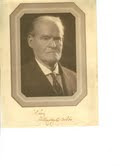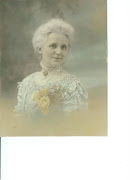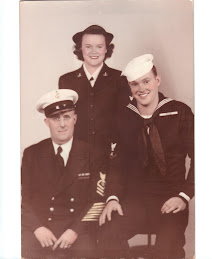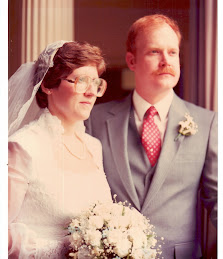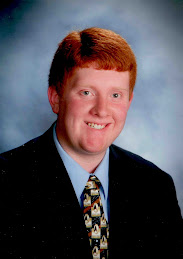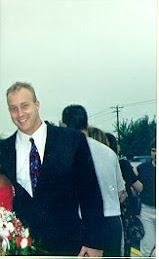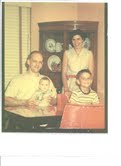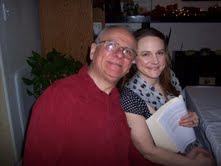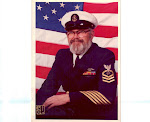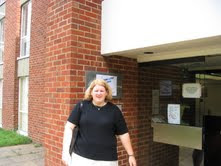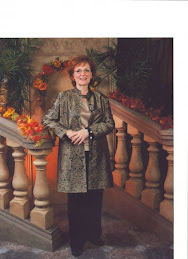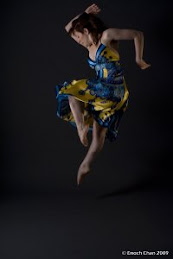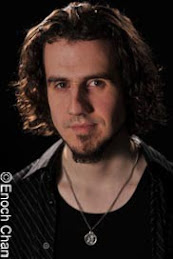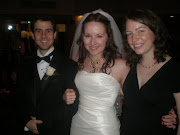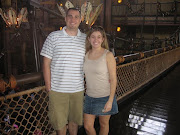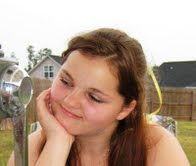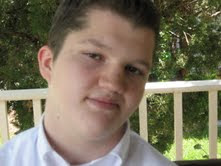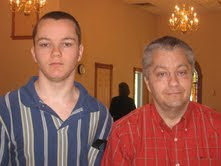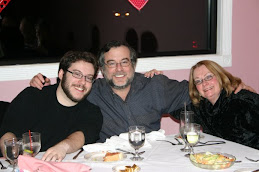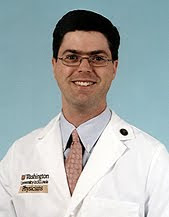Friday, November 28, 2008
William Drewery Dobbs - Generation 3
William Drewery Dobbs makes his first appearance in the Census in 1820 in Norfolk, Virginia as the second son of Willoughby Dobbs and his wife, Rachel Edmonds. According to the genealogy data handed down to me by Nellie West Dobbs, the granddaughter of his brother Joseph, William was born in 1816.
I often wondered how he was named. Who was the Drewery from whom his middle name is derived? This is what I found...
It is curious to note that several lines below Willoughby’s listing in the 1820census is a listing for a man named William Drewery. He is a single man and is listed in the same age grouping as Willoughby. My speculation is that Willoughby named his son after this man. Was he a friend or a relative? Could he have been the child’s godfather? We may never know. I can’t find any other records of the name Drewery being used in any other Dobbs family members, although Drewery, Drewry, Drury were common names in the Norfolk area during the time of his birth.
According to the 1820 and the 1830 census, William had three brothers and five sisters. I know the name of only one of his brothers (Joseph, the grandfather of the aforementioned Nellie) who I will write about in another posting. Do any of you other Dobbs descendants reading this know who the others are?
In the 1840 Census, William is living in Portsmouth, VA with the following household composition – 1 male between 20 and 30, 1 male between 30 and 40, 1 female between 10 and 15, 1 female between 15 and 20, and 1 female between 50 and 60. My guess is that he is the male between 20 and 30 and his wife is the female between 15 and 20. The other male and female may be a brother and sister. The older female may be his mother Rachel Edmonds Dobbs. She passed away in 1846.
William’s first child, my grandfather, Charles Edwin Willoughby Dobbs, was born on August 12, 1840. On his death certificate, his son, Charles Dobbs from Louisville, KY, listed his father’s name as William D. Dobbs and his mother’s name as Elizabeth Lesley. My best guess is that Elizabeth died in childbirth and William married Martha Anne Leslie soon thereafter. Charles Edwin Willoughby (a.k.a.Reverend CEW Dobbs, Baptist Minister) ) is shown as being 11 years old in the 1850 census and is living with William (age 34) and Martha (age 28).
I haven’t solved this mystery of the two mothers yet. Why are there two different spellings of Lesley/Leslie? Could they have been sisters or relatives? Were their family ties in Baltimore? When I entered Elizabeth Lesley into my Ancestry search engine, there were several of them in Baltimore.
William's wife, Martha Ann Leslie died on October 23, 1872 at age 50 according to her obituary that appeared in the Baltimore Sun on October 25, 1872. That means she was born in 1822 and in 1840, she would have been 18. William would have been about 24.
In the 1850 Census, William and Martha Ann are living in Norfolk, VA with the following children: Charles – 11, Anne – 9, William W – 7, Martha A – 5, and
George H. – 3. William’s occupation is shown as carpenter.
In 1855, tragedy struck Portsmouth with a Yellow Fever epidemic that killed a substantial portion of the population. Two of William’s children died on August 10, 1855– William W. age 12, and Virginia, age 2.
In the 1860 Census, the family is living in the Jefferson Ward of Portsmouth. William is 44, still a carpenter, with a personal estate worth $200.00. His children are Ann E – 18, George H. – 10, Mary – 8, Elizabeth – 3, Claudius E. – 2, Martha A. – 13. Also living with him are William C. Sheppard, age 26, a carpenter (possibly a boarder) and Thomas E. Dobbs, age 19, carpenter’s apprentice.
I will digress a little from the census to say a few words about Thomas because for the longest time, I couldn't figure out who he was just from seeing him in the census records. It was only after I conducted a thorough reading of all of Nellie's letters to Charles that I was able to decipher the mystery.
Thomas E. Dobbs is William’s nephew, the son of his brother Joseph. Thomas was a twin. His brother was Henry Joseph Dobbs, who, as a confederate soldier, carried the colors next to General Armistead during Pickett’s Charge in the Battle of Gettysburg. His daughter, Nellie West Dobbs, wrote this to my great-grandfather, Charles Dobbs, in a letter that I have in my possession. She also wrote that both Thomas and Henry had married first cousins and that both of them lost their wives in childbirth. I have been able to confirm this in Thomas's case. He married William’s daughter, Martha Ann. They are shown in the 1870 Census, married and living with William in Baltimore. She died on October 29, 1871 at age 24. When she died, Thomas bought 4 plots in the Old North Cemetery in Baltimore where he laid her and the child to rest.
The Gravesite in the Old North Cemetery
I actually visited there and found them in Area AA, Lot 99. Martha Ann is the only one with a headstone which shows her nickname as “Mattie”. It’s very worn and unreadable. Next to her stone is an obelisk, maybe to mark her child’s grave.
Martha Anne is in the first plot and was buried on November 1, 1871.
Her mother, Martha Anne is in the second plot and was buried on October 25, 1871. She died of a severe and lingering illness.
George H, age 36,one of William’s and Martha’s sons, is in plot three. He died of consumption.
There are a couple small children there as well. Emma Dobbs, a 6 month old child, was buried there on April 9, 1883. Charles Dobbs, a 3 month old child, was buried on November 8, 1874.
And finally, William D. Dobbs was buried there on May 22, 1886. He died of medullary cancer.
I don’t know who the children belonged to as of yet. Maybe some of you can help me.
Thomas Dobbs Remarriage
Thomas E. Dobbs remarried on the 25th of November 1873 to Adeline (Addie) Duvall. The Duvall’s were a prominent family in Anne Arundel County, Maryland from the early 1600’s. The original founding member of this family was a Huguenot named Mageen Duvall. Funny enough, Barack Obama’s mother is a descendant of this same family. Thomas and Adeline had one daughter, Mary, who died unmarried in 1918, maybe from the flu epidemic.
Back to the census
In the 1870 Census, the family has moved from Portsmouth, VA to Baltimore, MD. I searched in the City Directories to find out when William moved. The first time I can find him is in the 1867 City Directory. He is living at 228 Saratoga St as a boarder in the home of Mrs. Adeline Duvall, his future wife’s mother!!! I found no listing for him in 1868 or 1869. He reappears with his entire family in the 1870 census in Ward 7 of Baltimore, MD.
The children listed as living with him are Ann Eliza – 27, Elizabeth -14, George H, - 20, Claudius – 12, Joseph – 8, Martha – 22 married to Thomas – 29, and Mary – 18 married to John Fricker – 22.
In 1880, William is living alone at 208 German Street with his occupation listed as “Peddler.” He died in 1886 of medullary cancer.
A few comments about the Civil War...
I found a reference to William Dobbs in Footnote.com. There is a record that shows him enlisted in Company C, 3 Va. Reserves, in Booker’s Regiment of the Virginia Reserves. It lists him as a Private in 1864. There is another document that shows he was discharged from military duty before the organization of the company but was not known to have commanded any of the C Company in 1864. So, it looks like he never actually had to participate, perhaps because of his age and number of dependents.
Thomas E. Dobbs served as a Private in Captain William Richardson’s Company of the 9th Regiment of Artillery, Virginia Volunteers. It shows he was born in Portsmouth, VA and was 21 years old. It shows he was 5’ 6 ½” tall with a dark complexion, black eyes and black hair. He was a carpenter by trade. He enlisted on April 27, 1861 for 1 year. He was discharged by special order #72 on April 1, 1862 and was paid $11 as his final pay.
Since the Portsmouth area was devastated during the war and the economy was in shambles, I assume that the family moved to Baltimore because the economic conditions were much better for house builders. The common method of travel back then was by boat from the Port of Portsmouth to the Port of Baltimore. The roads were muddy and in disrepair after the war.
Summary
Our ancestor, William Drewery Dobbs, appears to have been a very hard working family man. His own father, Willoughby, died while he was still a young teenager. He must have had to work hard to help support his brothers and sisters and his mother. After his marriage, he endured many hardships, including the deaths of many loved ones - a spouse in childbirth, two children from yellow fever, his second wife from a long and lingering illness, and his daughter,Martha Ann’s from childbirth. Then there was the Civil War, a relocation to Baltimore, and his eventual death from medullary cancer at age 70.
He outlived two wives and several of his children. When he died in 1886, he was living alone and working as a peddler to support himself. He was buried in an unmarked grave next to his family members. Nobody would even know that he was there if they walked by. But I know he’s there and how important a role he played in our existence. I walked on his grave in quiet awe as I thanked him for his hard work and a life well spent.
Tuesday, September 2, 2008
Kedar Dobbs Neighborhood Happenings during the American Revolution
Source: Lossing, Field-Book of the American Revolution, 1850
We have already considered the flight of Dunmore from Williamsburg, and his attempt to destroy Hampton, and have alluded to his raising the royal standard at Norfolk, and proclaiming martial law throughout the colony, and freedom to the slaves. He made Norfolk harbor the rendezvous for the British fleet, and determined there to establish the headquarters of ministerial power in the Old Dominion. Previous to making an effort to take possession of the town, he sent a few soldiers and sailors ashore, under cover of the guns of the ships, to carry off John Holt's printing establishment, which was doing good service to the patriot cause. Holt, though a high churchman, was an ardent and uncompromising Whig. This outrage was committed, and two of Holt's workmen were taken away prisoners, without resistance from the people. The Tories were numerous, and the Whigs were overawed. The corporation of Norfolk sent a letter of remonstrance to Dunmore; it was answered by insult. This insult was followed by violence. Hampton was attacked, and depredations were committed upon the shores of the Elizabeth River. Repelled with spirit, Dunmore resolved to strike a blow of terror. With his motley force he penetrated Princess Anne county, to plunder and lay waste. He was successful, and emboldened thereby, declared open war. All Lower Virginia was aroused, and the government directed its whole attention to the portion of the state thus menaced. It was at this time that Dunmore's attempt to bring the Indians upon the colonists was made known. The people burned with fierce indignation. Colonel Woodford, who afterwards became a brigadier general in the Continental army, was sent with a detachment of minute-men into Norfolk county, and the militia of that section were called to arms. Adjutant Bullit accompanied him. Perceiving these preparations, Dunmore became alarmed. He constructed batteries and intrenchments at Norfolk, armed the blacks and Tories, and ordered the country people to send their cattle to the city for his use, under penalties for disobedience.
Apprised of the movement of Woodford, and the point from whence he might expect the approach of the Virginians, Dunmore resolved to fortify the passage of the Elizabeth River at Great Bridge. His force consisting of only about two hundred regulars, and a corps of Norfolk volunteer Loyalists, he beat up for recruits among the negroes and the vilest portion of society. He cast up breast-works upon the island, on the Norfolk side of the Great Bridge, and furnished them amply with cannons. This presented a serious obstacle to the Virginians, who could approach the batteries only upon a narrow causeway. With a motley force of regulars and volunteers, negroes and vagrants, in number about six hundred, Dunmore garrisoned his fortress. The Virginians constructed a small fortification, of semicircular form, near the western end of the causeway, the remains of which were yet quite visible when I visited the spot. From the breast-work a street ascended about a hundred yards to a church, where the main body of the patriots were encamped
On Saturday morning, the ninth of December, before daylight, Dunmore, who remained at Norfolk, ordered Captains Leslie and Fordyce to attack the redoubt of the patriots. He had been informed that they were few in number, and weak in skill and experience; he, therefore, felt certain of success. When the Virginians had beaten the reveille, Captain Fordyce, with about sixty grenadiers and a corps of regulars, was ordered to the attack. After firing one or two cannons and some musketry, he pressed forward, crossed the Great Bridge, burned the houses and some shingles upon the island, on which the tide-mill now stands, and made an attack upon the guards in the breast-work. The fire of the enemy was returned, and the assailants were thrown into confusion. Fordyce rallied them, and having brought two pieces of cannon over the bridge, and placed them on the island in such a position as to command the breast-work, led his men (about one hundred and twenty in number) steadily across the causeway, keeping up a constant and heavy fire as they approached Woodford's redoubt. Lieutenant Travis, who commanded in the redoubt, ordered his men to reserve their fire until the enemy came within fifty yards, and then, with sure aim, pour volley after volley upon the assailants as rapidly as possible. Believing the redoubt to be deserted, Fordyce waved his hat over his head, shouted "The day is our own," and rushed forward toward the breast-work. The order of Lieutenant Travis was obeyed with terrible effect. His men, about ninety in number, rose to their feet and discharged a full volley upon the enemy. The gallant Captain Fordyce, who was remarked by the riflemen, fell, pierced by fourteen bullets, within fifteen steps of the breast-works. His followers, greatly terrified, retreated in confusion across the causeway, and were dreadfully galled in their rear.
Captain Leslie, who, with about two hundred and thirty negroes and Tories, had remained upon the island at the west end of the bridge, now rallied the regulars, and kept up the firing of the two field-pieces. Colonel Woodford, with the main body of the Virginians, left the church at the same time, and advanced to the relief of the garrison in the intrenchments. Upon his approaching line the field pieces played incessantly, but the Virginians pressed steadily forward. Colonel Stevens, of the Culpepper battalion, went round to the left, and flanked the enemy with so much vigor that a rout ensued and the battle ended. The enemy left their two field-pieces behind, but took care to spike them with nails, and fled in confusion to their fort on the Norfolk side. The battle lasted only about twenty-five minutes, but was very severe. The number of the enemy slain is not precisely known. Thirty-one killed and wounded fell into the hands of the patriots, and many were carried away by their friends. Gordon says their whole loss was sixty-two. They fought desperately, for they preferred death to captivity, Dunmore having assured them that, if they were caught alive, the savage Virginians would scalp them. It is a remarkable fact that not a single Virginian was killed during the engagement, and only one man was slightly wounded in the hand, notwithstanding the two field-pieces upon the island hurled double-headed shot as far as the church, and cannonaded them with grape-shot as they approached their redoubt. The wounded who fell into the hands of the Virginians were treated with the greatest tenderness, except the Tories, who were made to feel some of the rigors of war. The repulse of the British at Great Bridge greatly exasperated Dunmore, who had remained in safety at Norfolk; and in his rage he swore he would hang the boy that brought the tidings. The motley forces of his lordship were dispirited by the event, and the Loyalists refused further service in arms unless they could act with regulars. The Virginians, on the other hand, were in high spirits, and Colonel Woodford determined to push forward and take possession of the city. He issued a pacific proclamation to the people of Princess Anne and Norfolk counties, and many of the inhabitants repaired to his camp. Those who had joined Dunmore on compulsion were treated kindly; those who volunteered their services were each hand-cuffed to a negro fellow-soldier and placed in confinement. On the fourteenth, five days after the battle at the bridge, Woodford entered the city in triumph, and the next morning, Colonel (afterward General) Robert Howe, with a North Carolina regiment, joined them, and assumed the command of all the patriot forces. Dunmore, in the mean while, had caused the intrenchments at Norfolk to be abandoned, the twenty pieces of cannon to be spiked, and invited the Loyalists and their Families to take refuge with him in the ships of the fleet. The poor negroes who had joined his standard were left without care or protection, and many starved.
Distress soon prevailed in the ships; famine menaced them with its keen fangs. Parties sent on ashore to procure provisions from the neighboring country were cut off, or greatly annoyed by the Virginians, and supplies for the multitude of mouths became daily more precarious. The ships were galled by a desultory fire from the houses, and their position became intolerable. At this juncture the Liverpool frigate, from Great Britain, came into the harbor, and gave boldness to Governor Dunmore. By the captain of the Liverpool, he immediately sent a flag to Colonel Howe, commanding him to cease firing upon the ships and supply the fleet with provisions, otherwise he would bombard the town. Thc patriots answered by a flat refusal, and the governor prepared to execute his barbarous threat. The morning of the thirty-first of December, Dunmore gave notice of his design, in order that women and children, and the Loyalists still remaining, might retire to a place of safety. At four o'clock on the morning of the first of January, the Liverpool, Dunmore, and two sloops of war, opened a heavy cannonade upon the town, and parties of marines and sailors went on shore and set fire to the warehouses. The wind was blowing from the water, and the buildings being chiefly of wood and filled with pitch and turpentine, the greater part of the compact portion of the city was in flames before midnight. The conflagration raged for fifty hours, and the wretched inhabitants, Whigs and Tories, saw their property and homes licked up by the consumer, and their heads made shelterless in the cold winter air, without the power of staying the fury of the destroyer or saving the necessaries of life. Not content with laying the town in ashes, the petty Nero heightened the terror of the scene and the anguish of the people by a cannonade from the ships during the conflagration. Parties of musketeers, also, went to places where people were collected and attacked them. Horror reigned supreme, and destitution in its worst features there bore rule. Yet a kind Providence guarded the lives of the smitten inhabitants; and during the three days of terror while the fire raged, and cannon-balls were hurled into the town in abundance, not one of the patriot troops was killed, and only three or four women and children were slain in the streets. Seven persons were wounded. The invading parties were uniformly driven back to their ships with loss. In these repulses the intrepid Stevens was conspicuous, and displayed all the courage of a veteran soldier. Colonel Stevens and his little band remained upon the site of Norfolk, until February, when, having removed the families and appraised the dwellings which remained, he caused them to be destroyed, that the enemy might have no shelter. Thus the most flourishing town in Virginia was made an utter desolation, but its eligible location insured its phoenix-like resurrection, and again, when peace returned, "beauty for ashes" soon characterized the spot. Howe divided his troops; some were stationed at Kemp's Landing, some at the Great Bridge, and others in Suffolk, whither most of the fugitives from the city fled, and found open-handed hospitality in the interior.
Dunmore's movements on the coast compelled the Virginians to exercise the most active vigilance. After Howe abandoned the site of Norfolk, the fugitive governor erected barracks there, but being prevented from obtaining supplies from the neighboring country, he destroyed them, sailed down the Elizabeth River, and after maneuvering for a while in Hampton Roads, he finally landed upon Gwyn's Island, in Chesapeake Bay, on the east side of Matthew's county, near the mouth of the Piankatank River. This island contains about two thousand acres, and was remarkable for its fertility and beauty. Dunmore's force consisted of about five hundred men, white and black. He cast up some intrenchments, and built a stockade fort, with the evident intention of making that his place of rendezvous while plundering and desolating the plantations on the neighboring coast. General Andrew Lewis, then in command of a brigade of Virginia troops, was sent by the Committee of Safety to dislodge Dunmore. On the eighth of July, he erected two batteries (one mounting two eighteen pounders, and the other bearing lighter guns), nearly opposite the point on the island where the enemy was encamped. The next morning, at eight o'clock, Lewis gave the signal for attack, by applying a match, himself, to an eighteen pounder. The ball passed through the hull of the Dunmore, which was lying five hundred yards distant; a second shot cut her boatswain in twain, and a third shivered one of her timbers, a splinter from which struck Lord Dunmore, wounded his leg, and smashed his china. Both batteries then opened upon the governor's fleet, camp, and works. Terror now prevailed in the fleet, and confusion in the camp. Almost every ship slipped its cables, and endeavored to escape. Dunmore's batteries were silenced; the tents of his camp were knocked down, and terrible breaches were made in his stockade. The assailants ceased firing at nine o'clock, but no signal of surrender being given, it was renewed at meridian.
Early on the following morning, having collected some small craft in the neighborhood, Lewis ordered Colonel M'Clanahan, with two hundred men, to cross to the island. The enemy evacuated before the Virginians landed, and fled to the ships, leaving their dead and many wounded behind them. A horrible scene was there presented. Half-putrefied bodies lay in almost uncovered shallow graves, and the dying, scattered in various directions, were filling the air with their groans. The island was dotted with graves, for the small-pox and fevers had raged with great violence in the fleet and in the camp for some time. Some were burned in the brush huts, which took fire; and others, abandoned to their fate, had crawled to the sandy beach and were perishing. Only one man of the assailants was killed. Captain Arundel, who was slain by the bursting of a mortar of his own invention. The loss of the enemy could not be ascertained, but it must have been considerable.
On leaving the island, Dunmore caused several of his vessels, which were aground, to be burned, and with the remnants of his fleet he sailed out of the Chesapeake, entered the Potomac, and, after plundering and desolating several plantations on that river above Aquia Creek, he returned to Lynn Haven Bay, where he dismissed some of the ships for the Bermudas, some to the West Indies, and some to St. Augustine, with booty, among which was almost a thousand slaves. He soon joined the naval force in New York, and toward the close of the year sailed for England.
After the departure of Dunmore, the Virginia coast enjoyed comparative quiet until 1779, when a British fleet, under Admiral Sir George Collier, entered Hampton Roads. He sailed up the Elizabeth River and attacked Fort Nelson, which had been erected by the Virginians a little below Portsmouth to secure that place, Norfolk, and the navy-yard at Gosport from attack. The fort was garrisoned by about one hundred and fifty men under Major Thomas Matthews, who, on the approach of Collier, and General Matthews, who commanded the British land forces, abandoned it, and retreated to the Dismal Swamp, leaving the American flag flying from the ramparts. The British took possession of Portsmouth, Norfolk, Gosport, and Suffolk, on the eleventh, all being abandoned. Great quantities of stores, ammunition and cannons, fell into the hands of the invaders. A large quantity of naval stores were carried away; the residue, and a great quantity of tobacco, were burned or otherwise destroyed. After pillaging Portsmouth and destroying Suffolk, the fleet, with General Matthews and his land forces, well to sea, returned to New York, and assisted Sir Henry Clinton in taking possession of the fortresses on Stony and Verplanck's Pointe, on the Hudson.
Again, in 1780, hostile vessels were in the Elizabeth River. Brigadier-general Leslie, with about three thousand troops from New York, landed at Portsmouth, and took possession of every kind of public property there and in the vicinity. Leslie was to cooperate with Cornwallis, who proposed to enter Virginia from the south. He did not remain long, for Cornwallis, hearing of the defeat of Ferguson at King's Mountain, hastily retreated; and Leslie, on being advised of this, left for Charleston, for the purpose of joining the earl in the Carolinas. Again, in 1781, hostile troops, under Arnold, were on the shores of the Elizabeth. That expedition we will consider presently...[p. 333]
[p. 334]... We have mentioned on page 230 the retreat of Arnold down the James River after his depredations at Richmond. He proceeded to Portsmouth, where he took post, and began to fortify on the twentieth of January. Generals Steuben, Nelson, Weedon, and Muhlenberg were actively engaged in collecting the militia to defend the country and drive out the invaders, and Washington devised a plan for capturing the traitor. Having learned that four British ships, which had been lying in Gardiner's Bay, off the east end of Long Island, had gone eastward, and that two of them were disabled in a storm, he requested Rochambeau to send the French fleet (then commanded by D'Estouches, the successor of Admiral Ternay) and a detachment of his land forces to the Chesapeake. At the same time, he sent La Fayette thither with a detachment of twelve hundred infantry. The plan was to attack the traitor by sea and land simultaneously, so that he could not escape from the Elizabeth River. A part, only, of the French fleet was sent, under De Tilley, with orders to attempt the destruction of the British fleet there. They took or destroyed ten small vessels. They also captured the Romulus, a handsome, well-furnished vessel, at the entrance of Lynn Haven Bay, and carried her into Newport harbor. This expedition accomplished nothing respecting Arnold; and Washington, anxious to have co-operation with La Fayette and the Virginia militia against the recreant, went to Newport and held an interview with Rochambeau. The result was that the French fleet left Newport on the eighth of March. They were followed by the British fleet, then in Gardiner's Bay, under Admiral Arbuthnot, who intercepted the French at the entrance of the Chesapeake. They drew up in battle order, eight ships on a side, and a partial engagement ensued. Neither party could justly claim a victory. The French abandoned their design of co-operating with the marquis, and returned to Newport. The plan, so well arranged and so nearly accomplished, was defeated. La Fayette marched back to the head of Elk, and Arnold was left to the skill and bravery of the Virginia troops near him. These were inadequate to drive him from Portsmouth, and be remained there until about the middle of April, when he was joined by a detachment under Major-general Phillips. The two commanders now determined to overrun all the fertile portion of Virginia lying near the James River, and on the twenty-fourth of April they reached City Point with twenty-five hundred troops...
Saturday, August 30, 2008
Kedar's Daughter Nancy Dobbs and husband David Manning
David Manning: Nancy, his widow. A letter from J.W. Baxter,
County Clerk of Currituck, N.C. 4 Jan 1854 stated that he had found the
marriage bond between David Manning and Nancy Dobbs and it is the only evidence
he has or did have at that time. They were married 31 May 1810. Her
declaration in 1856 at aged 67 was signed in Richmond, stating he was a private
in Nathaniel Tatum's Co. He died in Norfolk Co. in October
1818.
A memo in quotation marks reads: David Manning, son of Thos. Manning
and Unis, his spouse, was born the 4th of August 1787. Nancy, daughter of
Kedar and Mary Dobbs, was born 24 Sept 1789. Elizabeth Manning, daughter
of David and Nancy, was born 15 March 1813. Frederick W. Manning, son of
David and Nancy, was born 8 November 1815. William Manning, son of David
and Nancy, was born _January 1818.
Wednesday, August 27, 2008
Virus Genealogicus
Yes, this is something crazy.
É um hobbie que não tem fim. It is a hobbie that has no end.
Mas não tem como explicar. But is not explain.
A esse respeito, do muito que já li em diversos textos e obras me identifiquei com o posicionamento do Padre Reynato Breves, no artigo Novas Revelações da Genealogia, publicado no Jornal da Cidade, de Barra do Piraí, em sua edição de 12 de setembro de 1998. In that respect, much of which already have read in various texts and works I identified with the position of Father Reynato brief, Article New Disclosure of Genealogy, published in the Journal of the City of Barra do Piraí, in its edition of September 12, 1998.
Diz o seguinte: It says:
Há pessoas que não apreciam ‘Genealogia’, não se interessam por saber quem é seu avô, bisavô ou trisavô; não querem saber de onde vêm, quais são os seus ascendentes. There are people who do not enjoy 'Genealogy', is not interested in knowing who is his grandfather, great grandfather or trisavô; not want to know where they come from, what are their ancestors.
Ora, a Genealogia é a Ciência da nossa racionalidade, da marca indelével das nossas origens; diz de onde viemos, diz quem somos, diz quais são as nossas raízes, mostra-nos a nossa importância. However, the Genealogy is the science of our rationality, the indelible mark of our origins, says of where we come from, says about us, says what are our roots, shows us our importance.
A Genealogia exige paciência, perseverança e intercâmbio, mostra a necessidade da comunicação com outros Genealogistas e causa grandes surpresas e grandes emoções. The Genealogy requires patience, perseverance and exchange, shows the need of communication with other Genealogistas and causes great surprises and big emotions.
Enfrenta grandes obstáculos, terríveis barreiras, surpreendentes interrogações. Faces major obstacles, terrible barriers, surprising questions.
A Genealogia é uma paixão e quem nela entra dela não sai mais. The Genealogy is a passion and who do not enter it comes out more.
A Genealogia é amor; amor aos antepassados. The Genealogy is love, love the ancestors.
A Genealogia é gratidão; gratidão aos que nos antecederam nesta vida. The Genealogy is gratitude; gratitude to those who preceded us in this life.
A Genealogia é memória imperecível. The Genealogy is imperecível memory.
A Genealogia quase se confunde com a Heráldica. The Genealogy almost be mistaken for the Heraldry.
A Genealogia atesta a importância de uma Família. The Genealogy shows the importance of a Family.
A Genealogia é como o Livro; conserva a memória das gerações passadas contra a tirania do tempo e contra o esquecimento dos homens, que ainda é a maior tirania, e enaltece as gerações hodiernas. The Genealogy is like the Green; retains the memory of past generations against the tyranny of time and against the neglect of men, which is still the greatest tyranny, and brings the generations hodiernas.
A Genealogia move os ânimos e causa grandes efeitos. The Genealogy move the very souls and cause large effects.
Wednesday, August 20, 2008
Dobbs Crest - the Willoughby Barrett Version

Saturday, August 16, 2008
Brian Dobbs - Generation 9
 Brian's genealogy
Brian's genealogy1. Kedar Dobbs 1748 - 1816
2. Willoughby Dobbs 1782 - 1829
3. William Drewery Dobbs 1816-1886
4. C. E. W. Dobbs 1840 - 1916
5. Charles Dobbs 1871 - 1928
6. George Whipple Dobbs Sr. 1896 - 1971
7. George Whipple Dobbs Jr. 1921 - 1990
8. George Whipple Dobbs III 1954 -
9. Brian Cory Dobbs 1981
The History Of Recorded Music ( 3 Discs) is the all-encompassing solo album. It is written, performed, produced, financed and documented by myself, Brian Dobbs.
This album includes a Vinyl CD, a DVD-Video and a DVD-Audio disc. I shot and edited all of the video, authored both DVDs and designed my own way of multichannel mixing. I also designed the album artwork with the help of photography expert Enoch Chan.
The History of Recorded Music Vinyl CD16 bit, 44.1 kHz, Stereo
1) Breathe, Into My Soul
2) Biolume
3) Needle Whip
4) The Spirits of Tomorrow
5) Superior(ity)
6) Stand the Test of Time
7) X Max
8) Light Emitting Diad
9) Breathe, Into My Soul (reprise)
Comments:
When recording for this album began there were only rough ideas floating around, mostly stored as demos on my computer. The songwriting process was linear, working and completing one song at a time. I ultimately wanted to hear certain types of songs and sounds, so once I was done with one type I then moved on to the next. For instance, I wanted a heavy metal song, an electronica song, an epic song, etc.
Once the creative process of composing and demoing a song on my computer was complete I went to the recording studio and tracked it.Composing the next song wouldn't begin until I was mostly done tracking the previous song. It's not the most efficient way of doing things, but I unfortunately never had the luxury of isolating myself for a month or two and knocking this thing out.
From conception to completion this album took one-and-a-half years. Besides the fact that I took over the roles of guitarist, bassist, keyboardist, drummer, songwriter, producer, videographer and editor, I had to fit this thing in-between having a full-time job and being the drummer and webmaster for Concrete Prophet, my band. Since I also paid for studio time myself I had to budget the recording process from paycheck to paycheck.
I am not listing complaints, I just wanted to express the reality of the whole process.I loved experimenting with synthesizers on this album. I never worked with the keyboard intimately before, but once I started doodling I found myself completely immersed into the world of patches and effects. The keyboard sneaks it's way into most of the songs, sometimes producing interesting musical hybrids.
I find it difficult to classify the album into any one particular genre however. I suppose most of the material on here is derivative of rock music, but I wouldn't call this a rock album. I'll leave that up to you.
Visuals to the Aural Medium DVD-Video16x9 Anamorphic Widescreen, Dolby Digital 2.
1) Interview with Brian Dobbs 2) Studio Footage 3) Music Videos
Comments:
I thought it would be interesting to put myself on camera to answer questions and offer some insight into the making of this album. Who am I? Where am I from? What were my motivations? Just how on Earth did I manage to do all of this? I do my best to give as much information as possible about my background, my reasons and methods for doing this as well as song-by-song analysis.
The interview is quite long, but after all this is my album.I knew going into this I wanted to get some video footage of the recording process. I didn't anticipate capturing the performances of most of the material but once this thing got started I thought it would be stupid not to set up the camera to capture exactly what would be heard on the album.
From that, I thought of making music videos to each song showcasing each instrument being recorded for that song. I refined the editing process as I went along but ultimately what you will see are simultaneous performances of myself playing each instrument for each song.
The History of Recorded Music DVD-Audio 24 bit, 44.1 kHz, Six Channel Surround Sound
1) Breathe, Into My Soul 2) Biolume 3) Needle Whip 4) The Spirits of Tomorrow 5) Superior(ity) 6) Stand the Test of Time 7) X Max 8) Light Emitting Diad 9) Breathe, Into My Soul (reprise)
Comments:
I'm a home theater nut. I love surround sound. Listening to music in surround sound can be a breathtaking experience. In a word, beautiful. About midway through the recording process I started thinking about whether it would be possible to include a surround mix of each song on the album. After doing some research I came across a company that sold DVD-Audio authoring software at a reasonable price. The only catch was that it didn't include the ability to mix in surround sound. The recording studio only had stereo mixing capabilities so I knew that I would have to start thinking creatively towards a solution.Ultimately what you'll hear is the music broken up into multiple channels.
I'm confident no one has attempted something like this before because I came up with the mixing process myself. In the process I think I drove my engineer crazy! In the beginning he had no idea where I was taking this project, but after time he eventually began to understand. His idea for an album cover was dressing me up as a mad scientist in a laboratory.
During the recording process I told some people about my plans for a surround sound mix to which most of them asked, "But why?" My answer is that I have faith in the future of multichannel music. I've been an early adopter of the virtually unknown (and misunderstood) format and I can now also consider myself one of the privileged few on this entire planet to have an independent DVD-Audio surround sound mix.
Friday, August 15, 2008
On the trail of the first Willoughby
Willoughby grew up and married Rachel Edmonds (b. 1784) on October 20, 1805 by Reverend William Grimes. This is well documented in Virginia records.
The first time that he appears by himself in the census records is in 1820. I assume that he was living and farming with Kedar before that because in the 1810 census, Kedar Dobbs is living in St. Bride's Parish with 6 other family members, none of whom appear to be his wife.
The 1810 Census shows Kedar as the head of household. He would have been 62 in 1810. He died in 1816. In addition to Kedar, there is one male between the ages of 26 and 44, One female between the ages of 26 and 44, and four children - three young females under 10 years old, and one female between the ages of 16 and 25. There was also 1 slave, gender unspecified.
Willoughby served as a private in the War of 1812 in the 9th Reg't (Sharp's) Militia. I don't know where or how much time he spent doing this.
In the 1820 Census, Willoughby is listed as the head of household and is 38 years old. Rachel is 36. In addition, there are 6 children - 2 sons under 10 years old, 3 daughters less than 10 years old, and 1 daughter between 10 and 16.
Willoughby is shown as being engaged in agriculture. There are no slaves listed.
By the 1830 census, Willoughby is not listed and presumed deceased and Rachel is 46 and there are 9 children - son less than 5 yrs, son 5-9 yrs, son 10-14 yrs, son 15 to 19 yrs, daughter less than 5 yrs, daughter 10 to 14 yrs, daughter 15 to 19 years, and two daughters 20 to 29 yrs. In addition, there are 5 slaves - 1 male 10 to 23 yrs, 2 males 24 to 36, 1 female under 10, and 1 female 24 to 36. It could be a family from the composition and ages.
In 1840, I can't find any Dobbs's in the Norfolk, Portsmouth, St. Bride's Parish area. What could have happened and where did they go?
The Federal Mortality Schedule lists a Miss Dobbs born in 1820 who died in 1850. This might be one of them.
Rachel Dobbs' obituary appeared in local newspaper in 1846 and reads:
"In Portsmouth, Va., on Saturday, the 5th inst., of Pulmonary Consumption, Mrs. Rachel Dobbs in the 62nd year of her age. She was a subject of many severe and heavy trials, but the everlasting arms were underneath her, and the eternal God was her refuge."
I can only imagine what these severe and heavy trials must have been with nine children, a farm, no husband, and the pre-Civil War economy.
Where is Rachel buried? Could Willoughby be with her?
What about the other siblings that I haven't found. I have traced two of them because I knew their names from my great-grandfather's, (Charles Dobbs), files.
William Drewery Dobbs, born in 1816, had ten children and lots of descendants.
His brother, Joseph E. Dobbs, had three children, died early of consumption, and had less.
Since this is the next generation, it will be grist for another blog on another day.
How to figure cousin relationships
I found this neat formula on another Dobbs genealogy site "Gathering Leaves". The Dobbs's on this website are from Middlesex County, Virginia and may have some relationship to us, but I can't find it yet.
Determine the latest common ancestor, and then the number of “G”s you share.
That is the number of cousins you are.
Any difference in “G”s is the number “Removed”.
So, people who have the same great-grand-parents (2G) are second cousins (2C).
If the great-grand-parents (2G) of one person are the great-great-grand-parents (3G) of another person, then those two people are second cousins, once removed (2C1R).
They share 2Gs with a difference of 1G (3-2=1).
First Dobbs Obituary 1551
From: 'Notes to the diary: 1556', The Diary of Henry Machyn: Citizen and Merchant-Taylor of London (1550-1563) (1848), pp. 347-355. URL: http://www.british-history.ac.uk/report.aspx?compid=45537. Date accessed: 15 August 2008.
How the name DOBBS came to be way back in history
The Surname Dobbs comes from the combination of DOB, a nickname for Robert and the S meaning "Son of". Families bearing this name were estimated at early dates in Oxfordshire, Norfolk, Yorkshire, Hartfordshire, and Glouscestershire in and about the city of London, and Scotland and Ireland, having come to the British Isles, at the time of the Norman conquest. They were largely of the lesser nobility. Among the earliest records of the name in England are those of Dobbs de Languel, who was living in Oxford in 1273. A Sir Richard Dobbs is recorded as having been Lord Mayor of London in 1551.
I have the genealogy all the way back to Richard and I found a UK website that lists his father's name as Robert.
Thursday, August 14, 2008
Is this our Matthew Barrett Dobbs?

Matthew Barrett Dobbs, MD
Clinical Specialty
Pediatric Orthopaedics with special expertise in Pediatric Foot Deformities
Clinical Interests
Clubfoot, Trauma, Scoliosis, Kyphosis, Leg Length Disorders, Congenital and Developmental Foot Anomalies, Congenital Pelvic and Hip Disorders, Perthes
Research Interests
Dr. Dobbs' research focuses on the genetic aspects of orthopaedic conditions. His research has led to the isolation of triphalangeal thumb to chromosome 7. He is currently involved in gene(s) searches for idiopathic scoliosis, clubfoot, and vertical talus.
Background
Dr. Dobbs completed his medical school education at the University of Iowa in 1991 and his orthopaedic surgery residency at the University of Iowa Hospitals and Clinics in 1995. He then completed a one year Pediatric Orthopaedic Surgery fellowship with additional training in pediatric spinal deformity in 2001. He is the recipient of the 2002 Hunterian Society Gold Medal. He has authored many articles and is active in research related to the genetic aspects of orthopaedic conditions. His research has led to the chromosomal localization of triphalangeal thumb. He is the 2002 recipient of the Hunterian Medal Award for his research entitled, "Localization of Dominantly Inherited Isolated Triphalangeal Thumb to Chromosomal Region 7q36."
Awards
Hunterian Medal (2002), for his research entitled “Localization of Dominantly Inherited Isolated Triphalangeal Thumb to Chromosomal Region 7q36"
Board Certifications
Board Certified, American Board of Orthopaedic Surgeons.
Medical Degree University of Iowa College of Medicine
Residency Orthopaedic Surgery, University of Iowa Fellowship
Pediatric Orthopaedics, Shriners Hospital for Children
Academic Office Mailing Address
Washington University School of Medicine Campus
Box 8233660 Euclid Avenue
Saint Louis, MO 63110
Description of Practice
All aspects of pediatric orthopaedics with a special interest in pediatric foot and spinal deformities. Dr Dobbs utilizes the Ponseti method in his treatment of clubfeet which avoids major surgical intervention in these children.
Clinical Office Locations
St. Louis Children's HospitalSuite 4 S-20One Children's PlaceSt Louis, MO 63110Shriners Hospital for Children2001 South LindberghSt Louis, MO 63131Hospital Affiliations
St. Louis Children's Hospital Shriners Hospital for Children Barnes-Jewish Hospital;
Common Procedures
Spinal fusion both posterior and anterior for pediatric scoliosis deformities; acute and chronic fracture care; Correction of congenital and acquired foot anomalies; Ponseti method of clubfoot correction; Operative management of hip and lower extremity disorders including developmental hip dysplasia, slipped capital femoral epiphysis, Perthes, leg length inequalities, and angular and rotational anomalies; arthroscopy
Common Diagnoses Treated
Idiopathic and Congenital Scoliosis; Spondylolysis and Spondylolisthesis; Clubfoot; Flatfoot, Vertical Talus; Acute and Chronic Traumatic Disorders; Congenital Hip and Pelvis Disorders; Leg Length Discrepancy; Neuromuscular Disorders; Skeletal Dysplasias; Sports Injuries
Milestones
Hunterian Medal (2002), for his research entitled “Localization of Dominantly Inherited Isolated Triphalangeal Thumb to Chromosomal Region 7q36"
Publications
Luhmann SJ, Schootman M, Schoenecker PL, Dobbs MB, Gordon JE: Complications and Outcomes of Open Pediatric Forearm Fractures. J Pediatr Orthop. 2004 Jan-Feb; 24 (1): 1-6.
Dobbs MB, Lenke LG, Walton T, Peelle M, Rocca GD, Steger-May K, Bridwell KH: Can We Predict the Ultimate Lumbar Curve in Adolescent Idiopathic Scoliosis Patients Undergoing a Selective Fusion with Undercorrection of the Thoracic Curve? Spine, 2004 Feb 1; 29(3): 277-85.
Dobbs MB, Gordon JE, Schoenecker PL: Absent Posterior Tibial Artery Associated with Idiopathic Clubfoot. A Report of Two Cases. Journal of Bone and Joint Surgery, 2004 Mar; 86-A(3): 599-602.
Bashiardes S, Veile R, Allen M, Wise CA, Dobbs MB, et al: SNTG1, the Gene Encoding Gammal-Syntrophin: A Candidate Gene for Idiopathic Scoliosis. Human Genetics, 2004 Jun; 115(1): 81-9. Epub 2004 April.
Gordon JE, Osland JD, Dobbs MB, Szymanski DA, Schoenecker PL, Luhmann SJ: Smoking and Socioeconomic Status in the Etiology of Legg-Calve-Perthes Disease. Journal of Pediatric Orthopaedics-British, 2004.
Dobbs MB, Rich MM, Gordon JE, Szymanski DA, Schoenecker PL: Use of an Intramedullary Rod for Treatment of Congenital Pseudarthrosis of the Tibia. A Long-Term Follow-up Study. Journal of Bone and Joint Surgery, 2004 Jun; 86(6): 1186-1197.
Dobbs MB, Gordon JE, Walton T, Schoenecker PL: Bleeding Complications Following Percutaneous Tendoachilles Tenotomy in the Treatment of Clubfoot Deformity. Journal of Pediatric Orthopaedics, 2004 Jul-Aug; 24(4): 353-357.
Gordon JE, Khanna N, Luhmann SJ, Dobbs MB, Ortman MR, Schoenecker PL: Intramedullary Nailing of Femoral Fractures in Children Through the Lateral Aspect of the Greater Trochanter Preliminary Results of a New Technique in 15 Children. Journal of Orthopaedic Trauma, 2004 August; 18(7): 416-422.
Dobbs MB, Walton T: Autosomal dominant transmission of accessory navicular. Iowa Orthopaedic Journal, 2004; 24:84-5
Dietz FR, Albanese SA, Katz DA, Dobbs MB, Salamon PB, Schoenecker PL, Sussman MD: Slipped Capital Femoral Epiphysis in Down Syndrome. Journal of Pediatric Orthopaedics, 2004 Sept – Oct; 24(5): 508-513.
Welcome to Cousin Gail Frances Dobbs
I read portions of your blog with great interest. My name is Gail Frances Dobbs. I am a member of The Dobbs Family - Generation 5 as noted on your blog. My great-grandfather is Charles Willoughby Barrett Dobbs, my grandfather is his son, Carl (my grandmother is the wonderful Mary Agnes Dougherty Dobbs) - you have listed their children as Charles and Arthur and that is correct, but you are missing one remarkable relative. My father - Willoughby Barrett Dobbs. He is their third child - and a simply beautiful human being.
My brother is Willoughby Barrett Dobbs Jr. - when I have some more time (soon), I will send you information to update your page, including information about my Dobbs cousins and my great uncles and aunts that I think you will find most helpful. For now, I just wanted to establish contact and let you know that I am here. Take care.
Kindest regards,
Gail
Kimmie Dobbs & Enoch Chan Wedding August 16, 2008 Toronto, Canada
 By Lisa TraigerSpecial to The Washington Post Friday, July 4, 2008; Page WE15
By Lisa TraigerSpecial to The Washington Post Friday, July 4, 2008; Page WE15 A New Troupe Deviates Far From the Norm
Kimmie Dobbs, standing, and Jennifer Klem will perform in "Aspiro," about a girl caught in unfamiliar territory. (By Enoch Chan)
" 'Deviated' means 'to depart from the norm,' " says company co-founder Kimmie Dobbs. "We're trying to do something different. All breakthroughs come from innovation: doing something different than has been done before."
This out-of-the-ordinary collection of performers, with choreographer Dobbs and her artistic collaborator, Enoch Chan, has created the world premiere of "Aspiro," with performances Saturday and Sunday at Dance Place in Northeast Washington.
An uneasy journey into the unknown underworld, "Aspiro" is the first full program by the newly minted Deviated Theatre, a local troupe that envisions making art that crosses disciplines and breaks barriers.
"From what I've seen of this new endeavor, the way Enoch and Kimmie combine different dance and theater disciplines . . . is really creative and innovative," says Alexandria writer and poet Magus Magnus, who collaborated with Chan on a poetry performance festival last year.
"We really want to have a company to love and take care of and to have fun with," says Dobbs, 24, who grew up in Anne Arundel County, dancing at the Ballet Theatre of Annapolis. She met Chan, 31, when they were both teaching at an arts summer camp in Northern Virginia. Chan was born in Hong Kong and grew up in Northern Virginia, attending Lake Braddock High School before studying theater at Boston University. He's active as a photographer in the local dance community.
Concepts influencing "Aspiro" were drawn from a 1998 painting by Chan of the mythical three Fates. The show, borrowing from contemporary dance, ballet, hip-hop, circus, vaudeville and movement theater, focuses on Dobbs's character, the Umbrella Girl, who is part waif, part wanderer, caught in unfamiliar territory. In her encounters with the circuslike cast, she becomes a stand-in for all of us: lost in the wilderness, trapped in a circus of the absurd, cornered with no exit in sight.
"Both Enoch and Kimmie," Magnus says, "have a unique artistic vision that they want to communicate to the audience, and it benefits from the cross-pollination that happens when the different disciplines work together."
Deviated Theatre Dance Place, 3225 Eighth St. NE. 202-269-1600.http://www.danceplace.org/. Saturday at 8 p.m., Sunday at 7 p.m. $8-$22. Deviated Theatre Dance Place, 3225 Eighth St. NE. 202-269-1600.http://www.danceplace.org/. Saturday at 8 p.m., Sunday at 7 p.m. $8-$22.
Wednesday, August 13, 2008
Look How Important One Person Is
Descendants of Kedar Dobbs
The first 4 generation male dobbs's are in big red bold font for easy sighting.
The four brothers in generation 5 from whom we are all descended are in blue bold.
I was able to cut and paste this from my Family Tree Maker File. Please comment on additions and corrections that you have knowledge of.
1 Kedar Dobbs 1748 - 1816
... +Mary Willoughby 1750 - unknown
....2 Willoughby Dobbs 1782 - 1835
....... +Rachel Edmonds 1784 - 1846
.......... 3 William Drewery Dobbs 1816 - 1886
............... +Martha Ann Leslie 1822 - 1872
.................4 Charles E W Dobbs 1840 - 1916
.....................+ 2nd wife Florence W Dobbs 1852 - 1936
......................... 5 Clarence Dobbs 1887 - 1918
......................... *1st Wife of Charles E W Dobbs:
...........................+Mary Elizabeth Barrett 1841 - 1884
.......................... 5 Charles Dobbs 1871 - 1928
.............................. +Katharine Whipple Dobbs 1861 - 1936
.................................6 George Whipple Dobbs Sr 1896 - 1971
................................... +Anna Helen White 1895 - 1976
.......................................7 George Whipple Dobbs Jr. 1921 - 1990
..........................................+Rosina Juanita Wastaferro 1915 - 1997
.............................................8 Rosemary Helen Dobbs 1950 -
............................................... + 2nd husband Charlie Perticari 1948 -
............................................*1st Husband of Rosemary Helen Dobbs:
................................................+Steven George Oakley 1946 -
...................................................9 Adrienne Lynn Oakley 1970 -
.................................................... + 1st George Riley Charles 1968 -
...........................................................10 George McKinley Charles 2000
........................................................*2nd Husband of Adrienne Lynn Oakley:
.........................................................+Richard Dean Anderson 1964 -
............................................................10 Brenner Dean Anderson 2006
......................................................9 Allison Marie Oakley 1971 -
..........................................................+William Joseph Goldstein 1965 -
..............................................................10 William Aric Goldstein 1997
..............................................8 Gilbert Charles Dobbs 1951 -
............................................. 8 John Heriot Dobbs 1953 -
.................................................+Janet Vermillion 1955 -
.......................................................9 Melissa Renee Dobbs 1979 -
...........................................................+David (not married)
.................................................................10 Caylee Dobbs 1998 -
...........................................................* 1st Husband of Melissa Renee Dobbs:
............................................................+Matthew Armstrong
..................................................................10 Matthew Jake Armstrong 2008
.........................................................9 Emily Rose Dobbs 1984 -
............................................. 8 George Whipple Dobbs 1954 -
...................................................+Karen Fesq 1953 -
..........................................................9 Brian Cory Dobbs 1981 -
..........................................................9 Kimberly Mae Dobbs 1983 -
..............................................................+Enoch Chan 1977 -
..............................................8 Carl Matthew Dobbs 1955 -
..................................................+Mary Evelyn Bird 1962 - 2006
...........................................................9 Thomas Matthew Dobbs 1987 -
...........................................................9 Zachary George Dobbs 1991 -
...........................................................9 Erica Joy Dobbs 1993 -
.......................................7 Katharine Elizabeth Dobbs 1919 - 2006
........................................ +Rogers L Hansel 1914 - 1975
..............................................8 Live Hansel
................................................ + Live Michael
........................................................... 9 Live Michael
............................................................9 Live Michael
.............................................. 8 Live Hansel
.................................................. +Live Harrison
.............................................................9 Live Harrison
............................................................... +Live Olmstead
..............................................................9 Live Harrison
................................................8 Live Hansel
.....................................................+Dec'd Outten 1947 - 1987
...............................................................9 Live Outten
..................................................................+Live Tylar
...............................................................9 Live Outten
..................................................................+Live wife
...............................................................9 Live Outten
...................................................................+Live Klauer
......................................................*2nd Husband of Live Hansel:
.......................................................+Live Scott
..................................................8 Live Hansel
..................................................... +Live Huckabee
.................................*2nd Wife of [6] Charles Dobbs:
................................. +Clara Landolt 1873 - 1966
................................... 5 Willoughby Barrett Dobbs 1861 - 1931
......................................... +Mary Ready Ragland 1862- 1917
............................................. 6 Hugh Barrett Dobbs 1885 - 1944
................................................... +Alma F Hemrich 1893 - 1972
...................................................... 7 Barrett Willoughby Dobbs 1908 - 1963
............................................................ +Doris Mae 1909 - 1972
...................................................... 7 Carolyn M Dobbs 1918 - 2007
............................................................ +Jack F Ray 1918 -
................................................................ 8 Carol Lynne Ray 1941 -
................................................................ 8 Jacquelyn M Ray 1945 -
...................................................................... +Thomas Selleck 1945 -
......................................................................... 9 Kevin Selleck 1966 -
............................................. 6 Paul W Dobbs 1887 -
............................................. 6 Carl Charles Dobbs 1889 -
................................................... +Mary Agnes Daugherty 1896 -
...................................................... 7 Charles Dobbs 1924 - 1960
...................................................... 7 Arthur Dobbs 1927 - 1994
.......................................................7 Willoughby Barrett Dobbs 1935 - 2002
...........................................................+ wife
....................................................................8 Gail Frances Dobbs
....................................................................8 Willoughby Barrett Dobbs, Jr.
............................................. 6 Mary R Dobbs 1892 - 1987
................................................... +Gordon J Simpson 1894 - 1974
...................................................... 7 Gordon Willoughby Simpson 1923 -
............................................................ +Jean Wiley - 1965
................................................................ 8 Gordon Wiley Simpson 1950 -
...................................................................... +Kim Masters
......................................................................... 9 Wiley Simpson 1986 -
............................................................................... +Boomer
................................................................................... 10 child Boomer
................................................................ 8 Jill Simpson 1952- 1965
................................................................ 8 Rebecca Simpson 1954- 1965
............................................. 6 Willoughby Barrett Dobbs Jr 1896 -
................................................... +Elizabeth M Dobbs 1897 -
...................................................... 7 Mary Ruth Dobbs 1921 -
............................................................ +Richard Harrington
................................................................ 8 David Harrington
................................................................ 8 Charles Harrington
................................................................ 8 Boy Harrington
................................................................ 8 Boy Harrington
...................................................... 7 John Richard Dobbs 1923 - 1993
............................................................ +Rita Helen Long 1926 - 2003
................................................................ 8 Willoughby Barrett Dobbs III 1948 -
...................................................................... +Ernestine Syre
..........................................................*2nd Wife of [7] Willoughby Barrett Dobbs III:
...................................................................... +Lucinda K Sensenig 1957 -
......................................................................... 9 Kristin Elizabeth Dobbs 1983 -
......................................................................... 9 Willoughby Barrett Dobbs IV 1992 -
................................................................ 8 Leslie Ann Dobbs 1952 -
......................................................................... 9 Matthew Dobbs Sweeney
................................................................ 8 John Edward Dobbs 1955 -
...................................................................... +Cynthia
............................................. 6 Theodore Roosevelt Dobbs 1900 - 1960
................................................... +Elsie Stacey 1891 - 1987
............................................. 6 Margaret Dobbs 1901 -
................................................... +Arthur Tompkins 1900 -
...................................................... 7 Mary Jane Tompkins 1922 -
............................................................ +M Anderson
............................................. 6 Elizabeth Dobbs 1903 -
................................................... +Alger J Ewald 1894 -
...................................................... 7 a.k.a. Betty Jane Fogle
............................................................ +Anderson
................................... 5 Leslie Edwin Dobbs 1864 - 1922
......................................... +Nettie Hurlbut 1865 - 1894
............................................. 6 Helen V Dobbs 1887 -
................................................... +Otto S Miles 1884 -
...................................................... 7 Harold N Miles 1909 - 1978
...................................................... 7 Mary C Miles 1913 -
............................................. 6 Florence Dobbs 1890 - 1925
................................................... +Fred W Maas 1884 -
...................................................... 7 Caroline Maas 1913 - 2007
...................................................... 7 Gerald Maas 1915 -
............................................. 6 Gilbert Dobbs 1891 -
................................... *2nd Wife of Leslie Edwin Dobbs:
......................................... +Lola E Buchanan 1869 - 1935
............................................. 6 Charles Dobbs 1898 -
................................................... +Goldie 1893 - 1978
............................................. 6 Edna M Dobbs 1900 - 1984
................................................... +Alva Kenneth McKee 1900 - 1984
...................................................... 7 Helen McKee 1925 -
............................................................ +A C January 1926 -
................................................................ 8 Ace January
................................................................ 8 Katherine January
...................................................................... +James Skelton
......................................................................... 9 Casey Skelton
............................................................................... +Karl Czyz
................................................................ 8 Susan January
................................................................ 8 Buddy January
...................................................... 7 John McKee 1927 -
...................................................... 7 Roy McKee
............................................................ +Darlene
................................................................ 8 Theresa McKee
................................................................ 8 Debra McKee
................................................................ 8 Kayla McKee
................................................................ 8 Boy Missionary McKee
................................................................ 8 Boy maybe McKee
............................................. 6 Leslie Dobbs 1907 - 1938
................................................... +Zeta Mae 1908 -
...................................................... 7 Howard Dobbs 1938 - 1977
............................................................ +Doris
...................................................... *2nd Wife of Howard Dobbs:
............................................................ +Wife Lindale
................................................................ 8 son Dobbs
................................................................ 8 son Dobbs
...................................................... 7 Dorothy Mae Dobbs
............................................. 6 John Jasper Dobbs 1908 - 1991
................................................... +Isla Alberta Hanna 1909 - 1990
...................................................... 7 Juanita Joyce Dobbs 1929 -
............................................................ +Marion Davis Williams 1927 - 2008
................................................................ 8 Marion Davis Williams 1947 - 1999
...................................................................... +Carol
......................................................................... 9 Wendy Williams
......................................................................... 9 Craig Williams
................................................................ 8 D Cecil Williams 1957 -
...................................................................... +Cindy Weber
......................................................................... 9 Justin Williams
......................................................................... 9 Whitney Williams
......................................................................... 9 Alexandra Karen Williams
................................................................ 8 Kyle Williams 1961 -
...................................................................... +Sharon
......................................................................... 9 Roxanne Williams
................................................................ *2nd Wife of Kyle Williams:
...................................................................... +Christy
...................................................... 7 Joann Frances Dobbs 1947 -
............................................................ +Tommy Gene Tompkins
................................................................ 8 Johnathan Ty Tompkins 1969 -
...................................................................... +Michelle Lee Killeen 1972 -
......................................................................... 9 Tia Frances Tompkins 1994 -
.............................................................*2nd Wife of Johnathan Ty Tompkins:
...................................................................... +Michelle Marcum
................................... 5 Gilbert C Dobbs 1867 - 1941
......................................... +Eula Jones 1874 -
............................................. 6 Esther Dobbs 1893 - 1972
............................................. 6 Nelson Barrett Dobbs 1907 - 1992
................................................... +Mary Agnes Jackson
...................................................... 7 Nelson Barrett Dobbs 1940 -
............................................................ +Marion Frances McNamera 1942 -
................................................................ 8 Matthew Barrett Dobbs 1969 -
...................................................... 7 Sister Dobbs 1941 -
............................................................ +Marler
................................... 5 Ann E Dobbs 1874 -
................................... 5 John Dobbs 1877 - 1886
................................... 5 Martha Ann Dobbs 1870 - 1891
.......................... 4 Anne Eliza Dobbs 1842 -
................................ +B E Smith
.......................... 4 William W Dobbs 1844 - 1855
.......................... 4 Martha A Dobbs 1845 - 1871
................................ + Thomas E Dobbs 1841 - 1922
.......................... 4 George H Dobbs 1847 - 1885
................................ +Mollie Muth
.......................... 4 Virginia Dobbs 1854 - 1855
.......................... 4 Mary Dobbs 1852 -
................................ +John Fricker 1850 -
.......................... 4 Elizabeth Dobbs 1857 -
.......................... 4 Claudius E Dobbs 1858 -
................................ +Annie L Dobbs 1864 -
................................... 5 William Durrel Dobbs 1881 -
......................................... +Lana 1885 -
............................................. 6 Kathreen Dobbs 1904 -
............................................. 6 Annie Dobbs 1906 -
............................................. 6 Elizabeth Dobbs 1906 -
............................................. 6 Bertha Dobbs 1910 -
................................... 5 Claudius E Dobbs 1882 -
......................................... +Emma G Rock 1883 - 1947
............................................. 6 Edward L Dobbs 1905 -
............................................. 6 Claude Dobbs 1906 - 1986
............................................. 6 William D Dobbs 1909 - 1991
............................................. 6 Ruben D Dobbs 1913 - 1984
............................................. 6 John J Dobbs 1916 -
............................................. 6 Joseph T Dobbs 1919 -
............................................. 6 Leo Rock 1898 -
............................................. 6 Mary V Dobbs 1926 -
................................... 5 Edward L Dobbs 1886 -
.......................... 4 Joseph E Dobbs 1862 -
................................ +Maranda W Groton 1862 -
................................... 5 Mable Dobbs 1885 -
................................... 5 Joseph Harold Dobbs 1887 -
................................... 5 Martha Dobbs 1891 -
................................... 5 Ethel V Dobbs 1895 -
......................................... +Warren Clark Donnelly 1894 -
............................................. 6 Warren H Donnelly 1921 - 1999
............................................. 6 Edmund H Donnelly 1924 - 1997
............................................. 6 Ethel V Donnelly 1926 -
................ 3 Joseph Edward Dobbs 1806 - 1850
...................... +Alethea Scott 1808 - 1852
.......................... 4 Henry James Dobbs 1841 - 1915
.......................... 4 Thomas E Dobbs 1841 - 1922
................................ + Martha A Dobbs 1845 - 1871
.......................... *2nd Wife of [12] Thomas E Dobbs:
................................ +Adeline Duvall 1849 -
................................... 5 Mary C Dobbs 1879 -
.......................... 4 Mary S Dobbs 1847 -
................ 3 Girl 1 Dobbs
................ 3 Girl 2 Dobbs
................ 3 Girl 3 Dobbs
................ 3 Girl 4 Dobbs
....... 2 Nancy Dobbs 1789 - (Kedar's daughter)
............. +David Manning 1787 - 1818
................ 3 Elizabeth Manning 1811 -
................ 3 Frederick W Manning 1815 -
...................... +Catharine A 1828 -
.......................... 4 Maria S Manning 1838 -
.......................... 4 William T Manning 1840 -
.......................... 4 Isabella R Manning 1845 -
.......................... 4 Clifton B Manning 1850 -
................ 3 William Manning 1818 -
....... 2 Child Dobbs (Kedar's unknown 3rd child)
Grandmas Just Wanna Have Fun


Symbols of my grandma... her cigarettes and her fuzzy purple hat... a Corset below.



These images are elements in my song about Grandmas through the generations. I can't format them very well in this blog, but I think you'll enjoy them anyway, especially after you read the words.
And a fuzzy purple hat
She buried treasures in her chest
And owned a baseball bat
She used to be a flapper
And dance into the night
But that was then and this is now
Her lap fits me just right
Chorus 1
Oh Grandma, Grandma
Having lots of fun
Grandma, Grandma
Her work was never done.
My mom became the grandma
And wore a blue housecoat
She made egg carton castles
Complete with cotton moats
She used to be a singer
And sing into the night
But that was then and this is now
She fits my kids just right
Chorus 2
Oh Grandma, Grandma
Having lots of fun
Grandma, Grandma
She wore a big fat bun
Verse 3
Now I am the Grandma
In t-shirts and blue jeans
I used to be a hippie
On the music scene
I keep treasures in my bosom
And sing into the night
My grandsons call me “Damma”
That name fits me just right!
Chorus 3
Oh, Damma, Damma,
Having lots of fun
Damma, Damma
Always on the run
Verse 4
Through the generations
Grandma’s play their part
Mischief making with the kids
Helps them to be smart
We always miss our grandma’s
It’s over much too soon
The treasure chests and castles
And brightly filled balloons
Chorus 4
Oh Grandma, Grandma
Having lots of fun
Grandma, Grandma
Her work was never done
Always love your Grandma
They know just what to do
Listen to your Grandma
Cause you might be one too!
Oh Grandma, Grandma
Having lots of fun
Grandma, Grandma
They all have big fat buns
Always love your Grandma
They know just what to do
Listen to your Grandma
So you can learn
To tie a shoe...
To make a stew...
To use some glue...
To run a crew...
To train a cockatoo...
To ride a kangaroo...
So you can be one too!!!
Friday, August 8, 2008
Same Regiments - Different Soldier
Kedar must have been one tough dude to have survived all of this. He was born in 1748 and died in 1816 at the age of 68. The soldier described below wasn't as hardy.
SPENCETOP@aol.com
Subject: James Spence Rev. War activity Date: Wed, 25 Nov 1998 22:06:38 EST
Following is the narrative written by James F. Carver, concerning the Revolutionary War activity of James Spence ( 1748-1793), husband of Jane Bluford Spence.
PVT. JAMES SPENCEJames Spence, at the age of 29, was drafted into the military during the Revolutionary War from Augusta County Virginia. James entered the Infantry on28 Aug 1777, as a Private, for a term of three years or for the duration of the War. James was assigned to the 15th Virginia Regiment then under the command of Lt. Col. James Innes in the Company of Captain Edwin Hull. ( James was promised 6 2/3 pounds per month as payment for his services.)
Lt. Col.Innes commanded James' unit only between Aug-Dec of 1777, then the command fell onto Maj. Gustavus B. Wallace. James' military unit would march from Virginia to Pennsylvania arriving at General George Washington's Winter Encampment at Valley Forge, PA by Feb.1778.
Pvt. James Spence would stand guard duty during the harsh winter weather months of Feb-Mar 1778. By April of 1778 while the winter weather was slowly changing, the harsh conditions had already taken it's toll on James. James was sick during the entire month of April. James would slightly recover during May when he returned to duty, but by June of 1778 James' illness got the best of him.
In June of 1778 James' unit fell under the command of Lt. Col. John Cropper and his company was still under the command of Maj. Gustavus Wallace. The military unit was then known as the 11th and 15th Virginia Regiment. (Higher command fell under Gen. Woodford's Brigade of the 2nd Battalion.) There, in June 1778 with good weather upon them, James' unit would march out of Valley Forge, PA northward towards New York, but left Pvt. James Spence behind. James was admitted into a hospital at Yellow Springs, PA, located just a short distance northwest of Valley Forge.
It was late May of 1778 when the 11th Regiment (1776-1778) and the 15th Regiment of Virginia were incorporated and designated (known as) the 11th and15th Virginia Regiment until Sept. of 1778. In July of 1778, the 11th and 15th Virginia Regiment arrived at White Plains, New York.
James was still sick but recovering at the Yellow Springs, PA hospital. James would finally rejoin his unit there at White Plains, NY, in August of 1778 where his company, commanded by Maj. Wallace fell under the command of Col. Morgan. James briefly joined the Artillery unit while there at White Plains NY. ( Probably so James could rest up more.)
Capt. Samuel Booker took command of James' company in Sept. 1778 when the11th and 15th marched to battle in Newark, New Jersey. James was back in the Infantry again at this time. The results of this NJ battle were many dead and again sickness spread throughout the military unit. James' unit would march back into New York where James laid over at Fishkill, NY, once again seriously ill. The entire unit of the 11th and 15th VA Regiment now under the higher command of Col. Abraham Buford laid at rest at Pompton, NY. The entire unit was listed as being " on fatigue". (Meaning the unit was too tired andtoo sick to engage in war activity. )
James, while under the high command of Col. Abraham Buford, would be given a leave of absence (furlough) at Camp Middlebrook ( NY location ? ) to return to Virginia. This furlough would be between Dec. 1778 and March 1779. James would faithfully return to duty at Camp Middlebrook in April of 1779 and fell ill once again. (It would be romantic to say that James was granted his absence to return hometo see and care for his loved ones, but I suspect that James was simply too ill to fight and hindered the unit's operations. This is obvious when he returned to duty still suffering from illness.)
Now under the high command of Major Webb, Capt. Samuel Booker's Company, James included, would be stationed at Camp Smith's Clove there in New York. Between May-June 1779 ( James sick entire month of May) Col. William Russell would replace Maj. Webb and in July of 1779 the 11th and 15th VA. Regiment moved around southeast NY and ended up in Haverstraw, NY in Oct. 1779. During the period Pvt. James Spence was in New York, it was viewed as the "seige of New York" when American soldiers were seriously attacking the British strongholds.The 11th and 15th VA. Regiment would more or less stand down between Nov-Dec 1779 near Camp Middletown, NY, probably due to winter weather. While no discharge papers were issued nor any records located so far, it appears that Pvt. James Spence was released/discharged at Camp Middletown, NY. James would return to Augusta County, VA.
While it would be nice to report that Pvt. James Spence was a hero of the Revolutionary War little is known about his actual combat experiences. James spent a total of 2 years and 4 months of military service time. During his tour of duty James spent 7 months of it off duty due to illness and 4 months off duty on personal leave. James Spence returned home to Augusta County, Virginia, to his family at the age of 31. Fourteen years later at the age of 45, James Spence would pass away. I have little doubt that the illness James suffered during the Revolutionary War played a serious role in his early death. Descendants from James Spence and his wife Jane Bluford can be traced throughout SW Virginia and even into Georgia.
END NARRATIVE
The above narrative was written Nov. 1998 by:James F. Carver610 Gay St. box 214 Portsmouth, OH 45662-0214e-mail:
heritage@zoomnet.net James encourages questions and comments . Please contact Jim if you have or need additional information.








